Snorkeling In Costa Rica: Where are the best places?
With incredible biodiversity, rich ecosystems and stunning landscapes, Costa Rica is hard to beat for land-based adventures. But, what about its expansive coastline for those seeking to explore the underwater world? Is it worth snorkeling in Costa Rica?
Costa Rica is a great destination for snorkeling, whether you are a family of water enthusiasts or are simply looking for an unforgettable experience. Knowing where and when to go snorkeling in Costa Rica can make the difference between a good day and an amazing one! It’s definitely worth doing a little research before you arrive, and that’s something we at Trekking the Dream can help you with.
We spent 3 weeks in Costa Rica in July, and discovered easy-to-reach coral reefs, hidden rocky coves and remote Pacific islands accessible only by boat. Hiring a vehicle gave us the freedom to explore at our own pace to access some of the best places to snorkel.
Our itinerary included Manuel Antonio and Santa Teressa on the Pacific Coast and Punta Uva on the Caribbean Coast. These were the gateways to some of the best places we found to snorkel in Costa Rica with our kids.
Some of the best places to snorkel in Costa Rica: Cahuita National Park, Osa Peninsula, Guanacaste province and Isla Del Coco.
Best Snorkeling In Costa Rica
Costa Rica offers several fantastic snorkeling spots, each with their own unique marine life and underwater landscapes. While some of the best places to snorkel are found on the mainland Caribbean Coast, most are located off the Pacific Coast.
Both the Caribbean and Pacific coasts offer warm water, but they are only clear at certain times of the year; don’t expect good year-round snorkeling at every location in Costa Rica.
Snorkelers often see intriguing marine life, including sea turtles, sharks, rays, eels, and a rainbow assortment of tropical fish. You may also see dolphins, whales, or manatees if you are lucky. Despite slightly limited visibility, due to sea conditions, our kids had close encounters with turtles and reef sharks in Punta Uva and countless tropical fish!
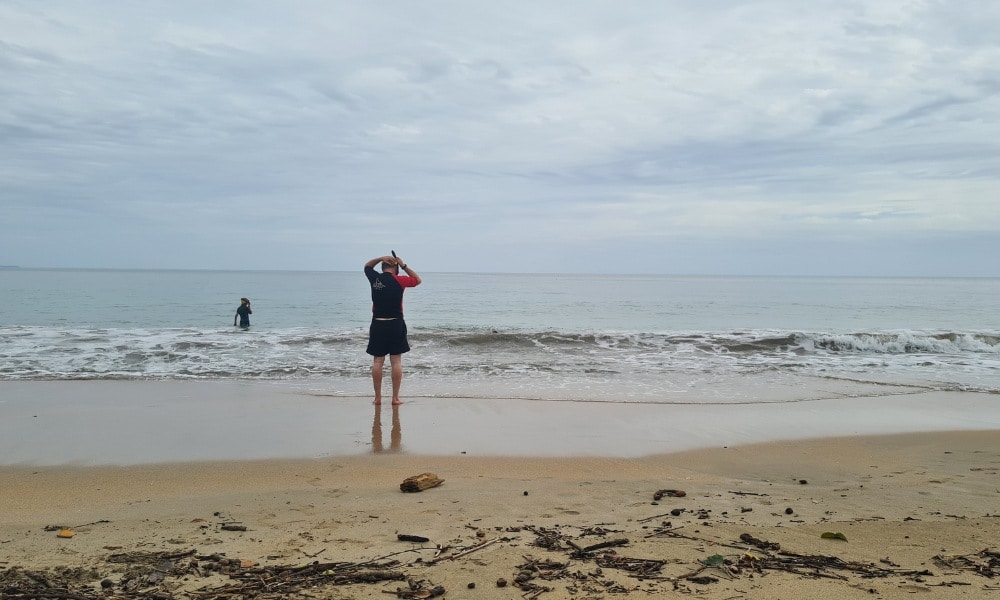
Snorkeling on Costa Rica’s Caribbean Coast
The dry season between June and October brings clearer water to the Caribbean Coast with September and October reliably having the best visibility. Visibility during the rest of the year can be poor, especially following rain. It is worth remembering that the ocean is usually calmer in the morning and this is the best time to snorkel.
Many of the coral gardens on this coast are ablaze with colour, with tropical fish and sea turtles frequently spotted. You could swim alongside parrotfish, angelfish or even perhaps the small but perfectly formed nurse shark.
1 | Cahuita National Park
The Southern Caribbean coast hosts Cahuita National Park, renowned for its extensive coral reefs. These thriving reefs support various colourful marine life and are considered to be amongst Costa Rica’s finest. They are certainly well worth a half-day visit!
The park’s underwater “Submarino Trail” allows both beginners and experienced snorkelers to explore the marine ecosystem at their own pace. You can also take a guided tour and learn more about the fascinating marine life and coral formations. The guides often enhance the snorkeling experience, pointing out quirky looking fish and features you might otherwise have missed.
Please note that Cahuita snorkeling is only accessible by boat and is possibly more suitable for families with older children.
2 | Gandoca-Manzanillo National Wildlife Refuge
The Gandoca-Manzanillo National Wildlife Refuge has 2 square miles (5 square km) of protected reefs that are accessible from the shore. Punta Uva and Playa Manzanillo allow direct access to the warm, calm waters of the refuge straight from the beach. This allows you to make the most of snorkeling the reef without needing a boat.
Amongst the huge array of wildlife, the endangered West Indian Manatee, also known as the gentle elephant of the sea, is occasionally seen grazing on the shallow sea bed.
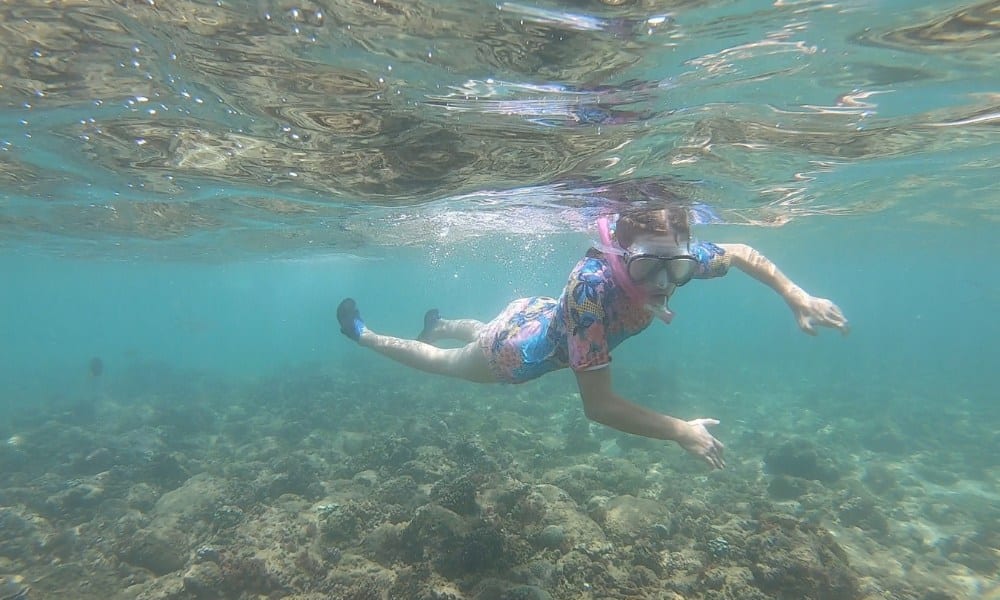
Snorkeling on Costa Rica’s Pacific Coast
December to April is the dry season across the Pacific Coast and typically has clearer water than the rest of the year. Visibility can still be affected if there has been rainfall in the previous few days or if it is particularly windy.
On this coast, you’ll find an incredible array of fish, turtles, rays, octopus and sharks. If you’re lucky, playful dolphins, migrating whales, or elusive seahorses may also cross your path!
3 | snorkeling in guanacaste, costa rica
Guanacaste, on the North Pacific Coast, has world-class golden beaches, hidden coves and bays and a diverse marine ecosystem offering a huge choice to avid snorkelers.
The Catalina Islands have unique volcanic rock formations that host several rare marine species. To get there, you’ll need to take a tour from the mainland, these are best booked well in advance. Nacascolo and Punta Huevos on the Papagayo Peninsula have particularly calm, clear water that is suitable for beginners or less confident swimmers.
There are plenty of more easily accessible snorkelling areas, too. Playas del Coco, Playa Ocotal and Playa Buena all have reefs that are directly reachable from the beach. Along the coast, Playa Flamingo and Playa Conchal have excellent snorkeling and are popular with both locals and tourists.
For those looking for hidden coves, the coastline of Tamarindo have plenty to discover, but only for those who are confident swimmers and when the sea is calm.
Our last pick in Guanacaste are the Islas Santa Catalina. Accessed via a short boat ride, this cluster of islands is renowned for its clear waters and the chance to see giant manta rays!
4 | Central Pacific coast of Costa Rica
The central Pacific Coast of Costa Rica boasts long sandy beaches interrupted by rocky areas, offering good snorkeling opportunities if the water is clear.
Jaco region has an excellent selection of beaches, including Playa Blanca, Playa Caletillas and Playa Mantas. All of these have safe, easy access to the water and relatively shallow reefs. Experienced snorkelers can explore the rocky coves of Punta Conejo, situated on an idyllic point near Puerto Escondido.
Few spots on earth are more beautiful than the Manuel Antonio National Park – where the rainforest and ocean meet. Snorkeling in Manuel Antonio is an experience you won’t find anywhere else! The rocky sea bed is home to thousands of colourful fish, but rain can restrict visibility.
The Gulf of Nicoya is hard to beat for a stunning tropical setting, with Isla Tortuga having clear waters, perfect sandy beaches, palm trees and even some shipwrecks. The 90-minute boat journey from the Nicoya Peninsula is well worth it for snorkeling.
The largest coral reef on the Pacific Coast can be accessed by boat and is located in the Marino Ballena National Park. It has world-class snorkeling and is a great spot for whale watching, especially during migrations.
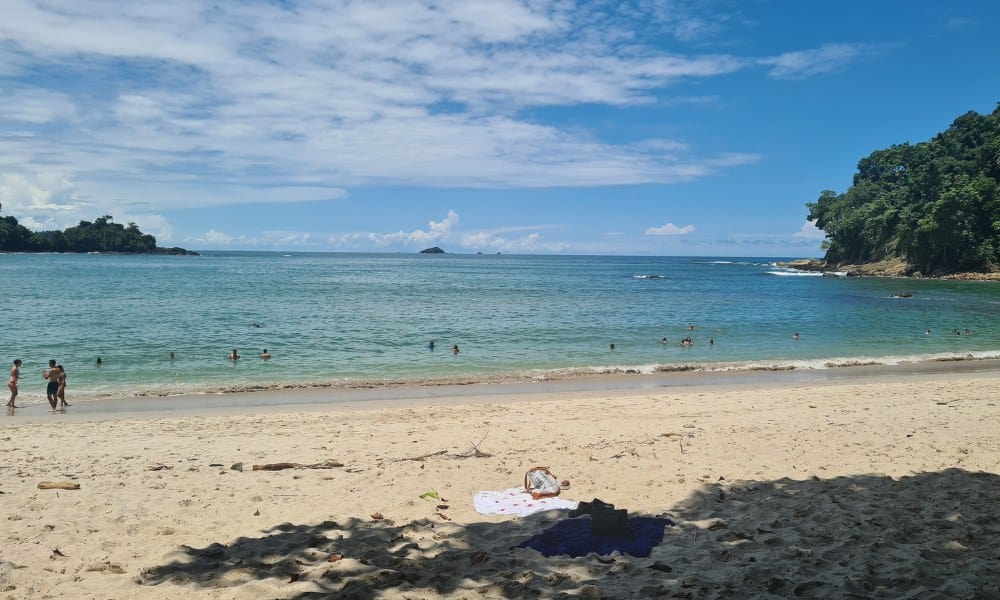
5 | Osa Peninsula
Snorkeling in the Osa Peninsula’s Gulfo Dulce offers encounters with large shoals of fish, several species of ray, spinner dolphins and even sharks. The peninsula is part of the Osa Conservation Area; although there is little coral, there is a huge amount of marine diversity. It is an ideal destination for wildlife enthusiasts and those looking for fabulous underwater photos.
The Golfo Dulce, a protected tropical fjord, is unspoilt and relatively secluded, making it suitable for families and beginners. The warm, clear waters harbour parrotfish, angelfish, rays, sea turtles. Dolphins, whale sharks, hammerhead sharks and humpback whales are also often seen here too.
Isla del Caño Biological Reserve, accessible by boat, presents an isolated island with diverse marine life, including parrotfish, surgeon fish, sharks, and rays.
6 | The Cocos Island National Park
Situated more than 300 miles from Costa Rica’s mainland, Isla de los Coco in the Cocos Island National Park, is the ‘ultimate’ snorkeling destination’. Experienced snorkelers and divers from around the world take a week-long liveaboard to one of Costa Rica’s most remote islands and the best snorkeling in Central America.
Although there are no permanent ‘human’ residents on this small island, wildlife thrives on the land and in the surrounding coral reefs. There are thousands of species including fish, molluscs, insects, birds, and plants that call this area home. Add the Scalloped Hammerhead Shark and you can see why this is a dream destination for nature lovers.
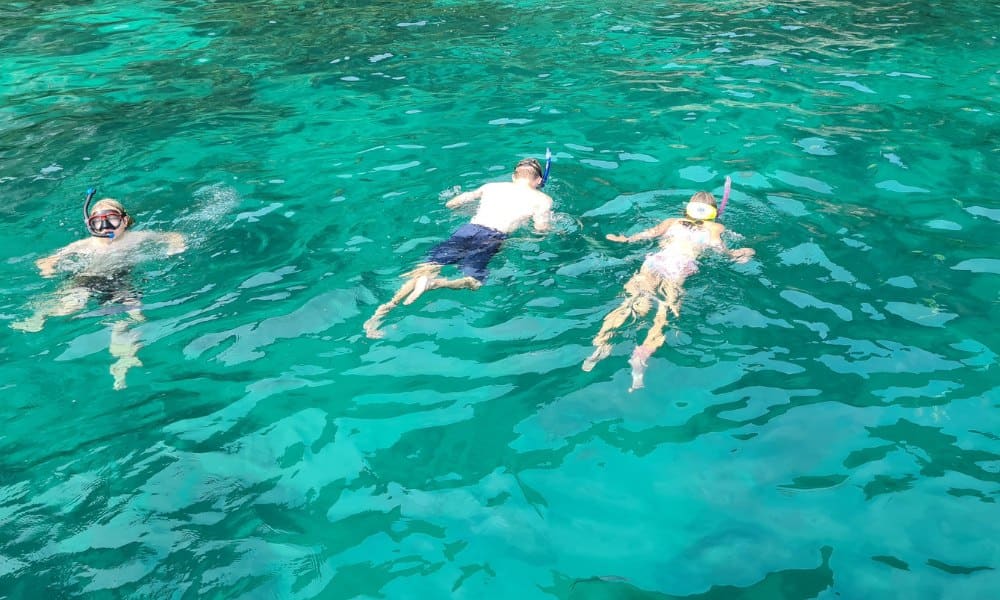
Best Time To Snorkel In Costa Rica
There is no single best time to visit Costa Rica. Consider the split seasons that occur at different times across the country and how they may impact your snorkeling plans.
| Caribbean Coast, Costa Rica | Pacific Coast, Costa Rica | Snorkeling Conditions | |
| Dry Season | June-October | December-April | Clearer water with optimum visibility. |
| Wet Season | November-May | May-November | Morning water clarity is clearer. Sealife more active |
| Optimal for snorkeling | September-October | December-April |
We recommend snorkelling during the dry season when the water is clearer. However, bear in mind that visibility and sea conditions can change quickly. Always snorkel responsibly in the company of others and take advice from locals.
Both coasts offer great opportunities to see a huge range of marine life. However, there is a larger opportunity for clearer conditions and snorkeling site options on the Pacific Coast.
>>>Check Out Our Favourite Snorkeling Destinations Around The World<<<
Tips For Snorkeling In Costa Rica
Snorkeling with young kids is a very different experience from snorkeling with older children, but both can be equally enjoyable.
- Consider the Season: Kids will usually prefer to snorkel during the dry season (December to April). With calmer seas and better visibility, you’ll have a more enjoyable, safer experience. Ensure you check the weather and sea conditions before snorkeling.
- Bring Your Own Snorkeling Equipment: Although often provided on tours, the quality may not be what you would expect. Bring your own snorkel, mask, and fins to ensure a comfortable, leak-free experience.
- Respect Marine Life: Maintain a respectful distance from the marine life and refrain from touching or disturbing coral reefs.
- Costa Rica Snorkeling Tours: Guided snorkelling tours can enhance your experience, especially when you have children with you. Guides will answer your kids questions while teaching them about the underwater world.
- Budget-Friendly Snorkeling: Access snorkeling destinations straight from the shore for a cheap activity.
- Snorkel Responsibily: Check the weather conditions and let someone know where your destination. Never snorkel alone.
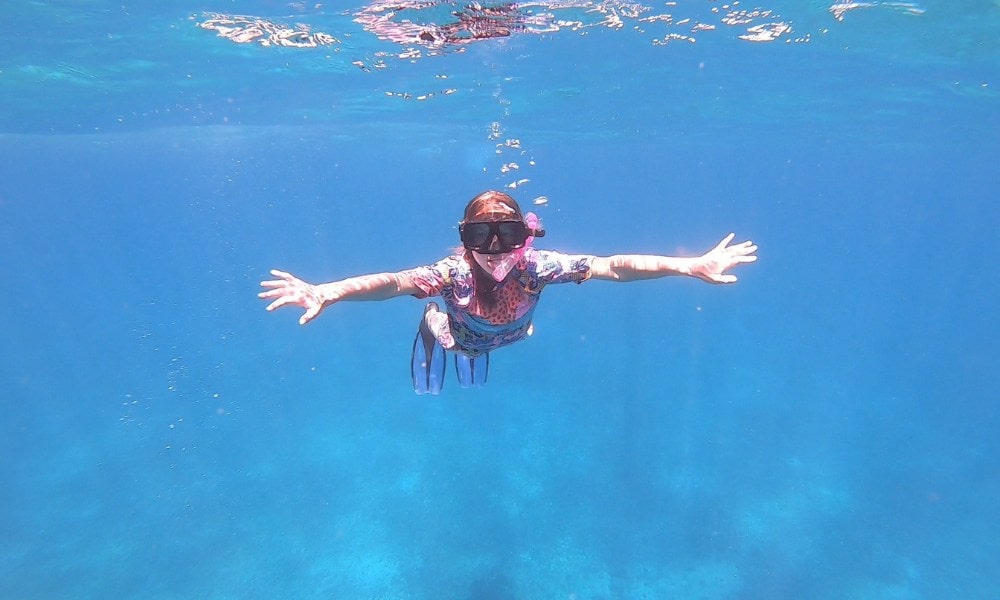
Snorkeling In Costa Rica: FAQ
These are some of the questions we’ve been asked when we share our experience of snorkelling in Costa Rica.
Is There Good Snorkeling In Costa Rica?
Yes! Costa Rica has consistently warm water throughout the year. Coral reefs, hidden rocky coves and remote Pacific islands provide perfect ecosystem biodiversity.
When to go snorkeling in Costa Rica?
The best time to go snorkeling in Costa Rica depends on where you want to go and what you want to see. The water along the Pacific coast is usually clear with ideal conditions during the dry season, from December to April. However, despite lower visibility underwater, the wet season, from May to November, offers lush landscapes and unique wildlife opportunities. The best months to snorkel on the Caribbean side are October and September when the water is clearest.
Are There Sharks In Costa Rica?
There are several shark species in the waters around Costa Rica. They include tiger sharks, hammerhead sharks, nurse sharks and reef sharks. Thankfully, shark attacks are incredibly rare and the water is generally considered safe for beach lovers and water sports enthusiasts.
What Can You See Snorkeling in Costa Rica?
You can see a huge variety of wildlife and some stunning reefs in the waters around Costa Rica. Whales, turtles, sharks, dolphins, octopus, seahorse, manatee and thousand of species of fish flourish in the warm, tropical seas.
Final Thoughts: Snorkeling In Costa Rica
Snorkeling is one of the incredible things to do in Costa Rica. The ocean is as diverse and awe-inspiring as its lush rainforests.
Whether you venture to the Caribbean coast or the Pacific, you will be pleasantly surprised. While both coasts offer great opportunities to see a huge range of marine life, there are more snorkeling options on the Pacific Coast with a greater chance of clear conditions.
Ensure you plan your snorkeling adventure to get the best experience and make it unforgettable for all the right reasons! We loved our time in Costa Rica, taking home plenty of special memories of its underwater world. We hope you do too!
